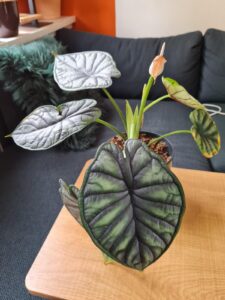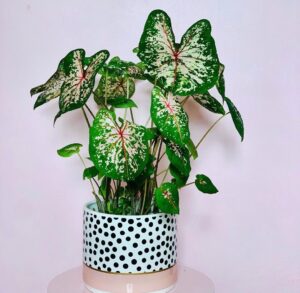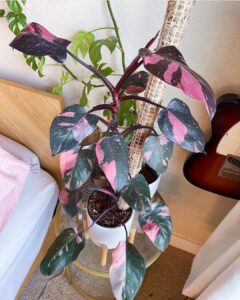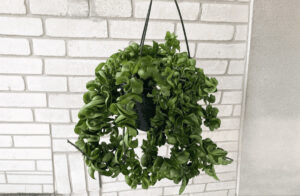
Have you ever seen a Prayer plant’s leaves fold up like hands in prayer at dusk? The Maranta leuconeura, commonly called Prayer plant, is one of my favorites for its fascinating movements. With heart shaped green leaves accented by a small pink or red stripe, this tropical plant from Brazil is sure to add a pop of color wherever you place it.
- Pros
- Unique movement of leaves opening and closing daily
- Low light requirements, great for apartments
- Bold foliage adds tropical vibes
- Easy care
- Cons
- Can be finicky with watering
- Toxic to pets if ingested
In this article
- 1 Appearance of the Prayer plant
- 2 Light Requirements for the Prayer plant
- 3 Watering the Prayer plant
- 4 Fertilizing the Prayer plant
- 5 Potting the Prayer plant
- 6 Propagation of Prayer plant
- 7 Growth and Development of the Prayer plant
- 8 Managing Pests and Diseases for the Prayer plant
- 9 Complimentary Plants with your Prayer plant
Appearance of the Prayer plant

The Prayer plant foliage is one of its coolest features. The heart shaped leaves are medium green and adorned with a small pink or red stripe. In the evening, the leaves fold upward in prayer position, giving the plant its name. Leaf sizes range from 3-6 inches. When happy, the Prayer plant produces small red bracts but usually it focuses its energy on healthy foliage. This beginner friendly plant thrives well in containers.
RELATED: My Top 5 Most Beautiful Houseplants
Great for People who:
Want an easy to care for houseplant that adds impact with its unique movement and foliage. Its bold leaves pack a lot of style.
Great for these Spaces:
The Prayer plant is perfect for low light rooms like bathrooms. Its compact size also makes it well suited to smaller spaces like coffee tables.
Prayer Plant Timelapse ⏳
byu/ashleycee7 inIndoorGarden
Caring for Prayer plant:
The Prayer plant is quite tolerant once you understand its needs. It prefers consistent moisture and humidity levels around 50%. Allow the top inch of soil to dry between waterings.
Toxicity Level of Prayer plant:
While non-toxic to humans, the Prayer plant can cause upset stomachs if ingested by pets. I keep mine high up since I have a curious cat. Just be mindful of where you place it if you have furry friends.
Light Requirements for the Prayer plant

The Prayer plant thrives in medium to low light conditions, between 500-1000 hours of indirect sunlight annually. It will cope well in rooms that get morning or afternoon sun. For low light areas, supplement with a grow light for 6-8 hours near the plant.
| Light Conditions | Effect on Prayer plant |
|---|---|
| Bright Indirect Light | Leaves remain healthy and may grow more compact |
| Low Light | Growth will be slower but plant can survive |
| Direct Sunlight | Leaves may burn, best to gradually introduce |
Watering the Prayer plant

The Prayer plant prefers consistently moist soil. I water mine when the top 1-2 inches are dry. In warmer months, water every 5-7 days. During fall and winter, water less frequently every 10-14 days. It’s best not to let the soil dry out fully or the leaves may die back.
- Check soil moisture daily by sticking your finger 1-2 inches deep
- Water thoroughly when top soil is dry
- Allow excess water to drain from bottom of pot
- Do not let plant sit in water
Fertilizing the Prayer plant
Like most houseplants, the Prayer plant benefits from occasional fertilizer to stay healthy and encourage new growth. I use a dilute liquid houseplant fertilizer every 2-3 waterings during the active growing season from spring to fall. Follow label instructions and flush with fresh water regularly.
| Month | Recommended Dosage |
|---|---|
| Spring (March-May) | 1/2 strength every other watering |
| Summer (June-August) | 1/2 strength every watering |
| Fall (September-November) | 1/2 strength every other watering |
| Winter (December-February) | No fertilizer |
Potting the Prayer plant
Love her!
byu/Yukiasa1 inhouseplants
Repot the Prayer plant every 1-2 years or when it’s rootbound in spring. Choose a container with drainage holes that is only 1-2 inches larger than the existing root ball. Use a well-draining potting mix. Water thoroughly after repotting and allow it to adjust for 1-2 weeks before increasing light or fertilizing.
- Carefully remove plant from current pot
- Prepare new pot and soil
- Place plant in center and fill sides with soil
- Firm soil gently and water
- Gradually increase light over 1-2 weeks
Propagation of Prayer plant
Propagating Prayer plants from stem cuttings is quite easy once you know the method. In spring or summer, take 4-6 inch cuttings from the mother plant, removing the bottom leaves. Place the cuttings in a glass of water and wait for roots to develop, usually 2-4 weeks. Then plant in soil. I’ve had great success with this cost effective way to grow more plants.
- Take 4-6 inch stem cuttings from mother plant
- Remove bottom leaves and place in water
- Change water weekly and watch for roots
- Plant in soil once roots are 1/4-1/2 inch long
- Water and care for new plant
Growth and Development of the Prayer plant

Prayer plants thrive in warm, humid conditions similar to their natural tropical environment. Daytime temperatures between 70-80°F and nighttime no lower than 65°F ensure fast growth. Medium to high humidity levels around 50-70% prevent brown spotting. They grow best in spring and summer under medium light. In fall and winter, reduce watering to encourage a dormancy period. Give the plant a good cleaning every few months by wiping leaves with a damp cloth.
Prayer plants can reach 2-3 feet tall and wide if growing conditions are optimal. You’ll see the most flourishing foliage and plant movement at this size. It’s a great time of year to introduce one to your home. Be patient, as this plant’s unique charm emerges over time with consistent care.
Managing Pests and Diseases for the Prayer plant
Prayer plants are generally carefree but periodically check for signs of pests like spider mites or mealybugs. Isolate any infected plants and wipe leaves with a diluted neem oil solution. Brown tips or spots could indicate too much direct sunlight, mineral buildup from hard water, or a fungus. Improve conditions or trim affected areas with sterilized shears.
Complimentary Plants with your Prayer plant
With its fascinating movements and tropical appearance, the Prayer plant makes a delightful addition for any home or office. Just be sure to keep its soil consistently moist and care for it similarly to other houseplants for long lasting enjoyment. Its bold foliage is sure to be the conversation starter in any room.
Frequently asked questions
Why do the leaves move?
The leaves fold inward at night and when the plant is under stress, thought to be a protective mechanism.
Can Prayer plants live outdoors in summer?
Only in zones 10-11. As a tropical, it’s not hardy and will perish with frost.
How do I get my Prayer plant to flower?
Flowers are rare in low light. Increase sunlight and warmth, and it may bloom small red bracts.
Mine is getting leggy, what should I do?
Take stem cuttings to propagate fuller plants or move it to a spot with more indirect light. The long stems mean it’s searching for sun.
What’s the best way to increase humidity?
Group plants together, use pebble trays or a humidifier especially in dry winter air. Low humidity leads to brown spots.
Happy gardening!







